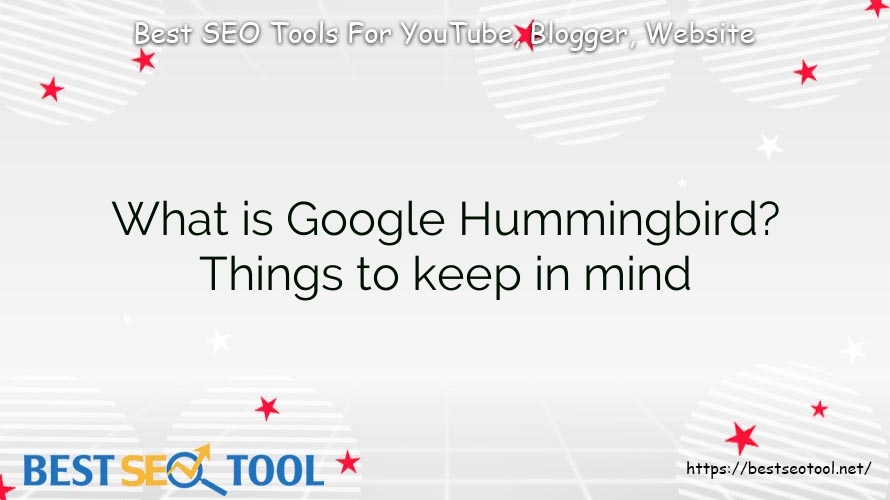SEO Basic, SEO Tutorial
What is Google Hummingbird? Things to keep in mind
Do you know what a Hummingbird is? Maybe you have known this animal in real wildlife, but have you heard of the Google Hummingbird Algorithm?
If not, do not rush, read this article immediately. Share Tool will help you find out:
- The concept of Google’s Hummingbird algorithm.
- Basic things you need to note about it.
Let’s start learning now!
What is Google Hummingbird?
Google Hummingbird was announced on September 26, 2013. But the expected release date is August 20, 2013.
Definition of Google Hummingbird
Hummingbird is the name of a new search SEO term that Google uses. Because Google believes it will bring better search results. Besides, data retrieval speed is extremely fast and more accurate.

Role
Did you imagine the overview of what a hummingbird is? Right?
The introduction of Google Hummingbird is to handle and understand mainly the impact of keyword semantics. That means it will focus on the meaning of that keyword, prioritizing related keyword phrases.
The most common use is to type in individual keywords and related sentences. Rather than targeting a few target keywords.
Hummingbird signals Google’s commitment to understanding searcher query intent. It’s the goals that are right for them to give more relevant results.
As if the Panda and Penguin algorithms have caused significant reports of lost traffic and rankings. Well, for this algorithm, there doesn’t seem to be a strong negative impact on the web in general.
This is largely understood to have a positive effect on the accuracy of Google’s knowledge base. It is also known as a Knowledge graph.
Knowledge graph and semantic search mean?
To fully understand the purpose it is important to first become familiar with the features of the search engine. These are Knowledge graphs and semantic searches.
Knowledge graph, useful things about it you need to know:
The knowledge graph is a set of SERP features designed. To provide quick, accurate answers to user queries. Be it about people, places, and things…
The SERP contains more than just standard organic results and links to relevant websites. It also contains a rich set of knowledge graph data.
The Knowledge Graph can be seen in action on the results page obtained when searching for “chocolate chip cookies”.
Includes a set of answers with a formula, and a knowledge panel on the right. This list contains nutritional information about desserts and suggestions for related search topics.
How does Google determine that:
Do these results reflect the searcher’s intent and satisfactorily address their needs?
Thanks to that, Semantic Search appeared.
Semantic search (keyword semantics)
Used to match SERP results that match the language of the user’s queries. Beyond the meaning of individual keywords, even if user intent is implicit rather than explicit.
Look at the Semantic search activity for the word “chocolate chip cookies” with the SERP above. Although the query itself is a cookie, semantic search extrapolates the words used in the search query.
Google allows to gradually increase the advantage of semantic search. Especially in real-world entities and their relationships to each other. Focus on matching query context based on Google’s Technology intelligence – intent analysis.
What is the sign of the Google Hummingbird?
When there was no Google Hummingbird algorithm. For example, you search on Google with the keyword “online science SEO best in Singapore”, then Google will return results focusing on important keywords such as SEO, and Singapore.
But Google Hummingbird will focus on all keyword semantics, even if you search with unsigned words. Google will still understand that you are looking for a place that offers a good SEO training program in Ho Chi Minh. From there, it will search for appropriate websites to return results for you.
With Google Hummingbird now, longer words will be understood by Google, including them in the results returned when users perform a search query.
This is an idea given by Google experts. They want the results page returned when the user makes a query to match and contain the full meaning of the query.
Voice search using Google Hummingbird
“Voice search” is one of Google’s latest examples. Google Hummingbird brings new voice search information. It can be found to be much more useful.

The special thing is that the Google Hummingbird algorithm on youtube will help you practice other languages by voice, especially English. Not only does it help you search for a word or two, but it’s easier to query an entire sentence.
Google Hummingbird and local search
While the basic SEO community tries to understand the effects of Hummingbird on the web in general. In contrast, the local SEO community addressed some perceived bugs from the update.

As the local SEO community speculates:
- This algorithm can have the following local effects on the local underlying results.
- A greater localization of organic results for queries with local intent.
- A significant presence of directory type results in local organic results.
How can I find out if I’ve been attacked by Google Hummingbird?
Although you or the local business owners may have encountered some temporary problems with spam. It reduces local search engine visibility. But in some cases, not most websites will experience a negative impact from this update.
If your site experiences a drop in traffic or rankings. Leads you to believe it might be caused by Google Hummingbird.
I recommend that you check Google’s complete list of updates. As it could also indicate that the change agent for your site is another update. Typically Google Panda or Penguin is not caused by Google Hummingbird.
With Hummingbird, it’s not about recovery – it’s about the opportunity!
Hummingbird has signaled to all website owners that:
- Google aims to increase understanding of the true intent behind user searches.
- By looking at the entire query for context instead of treating them as strings of keywords.
Hummingbird can be seen as bridging the gap between old practices, spam, and modern SEO. To find ways to speak your readers’ natural language, use their own words.
When your content is deemed relevant to searcher intent. Luckily, you not only have a chance to rank well organizationally but also to be placed in a SERP feature like an answer box or a knowledge panel.
In today’s search engine results, serving searcher intent is high on the SEO priority list.
You should use:
Incorporating direct interaction with the audience,
Keyword research
Thematic study
To help your website improve its visibility and rankings.
What to do to be friendly with Hummingbird?
Let me ask you a few questions, and try to answer them honestly:
Clear Object Building
When creating/optimizing a website, are you doing it with a clear audience in mind?
Follow SEO best practices
When doing site optimization are you following at least SEO best practices?
- Use a clear and uncomplicated information architecture;
- Avoid normalization problems
- Avoid thin content issues
- Creating a semantic content model
- Optimizing the website’s content on a page-by-page basis
- Use natural and semantically rich language with a strategy focused on landing pages
- Create useful content using several formats that you want to share with friends and link to
- Deploy Schema.org
- Open graph and semantic markup
Link Building
What are your link-building goals?
- Better brand visibility?
- Gain referral traffic?
- Raise your brand’s sense of thought leadership?
- Primarily related sites or thematically related sections of a more general website?
Thanks to the media that provides advantages for businesses
- Broader brand visibility
- Social echo
- Increase mentions, and links in the form of generating tools. Along with appearances and co-citations on other people’s websites
- Organic traffic and brand ambassador growth.
If you answered yes to all of these questions, there’s nothing you need to do but keep up the good work.
Only like that you have seen your website rank well and gain traffic. All thanks to the more holistic view of SEO you have.
Conclusion
Through the above article, have you understood what Hummingbird is? Let me recap again for you! Hummingbird can be considered to improve the experience of searching for full sentences. It’s not like before, it’s just keywords, individual key phrases of the user.
After knowing what a hummingbird is, I hope you can apply your knowledge for SEO better! That’s what I want to share with you. If you have any questions or concerns about this article, don’t hesitate to leave me a comment. Share Tool will always listen to your comments.

